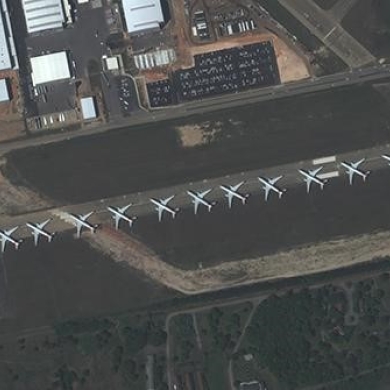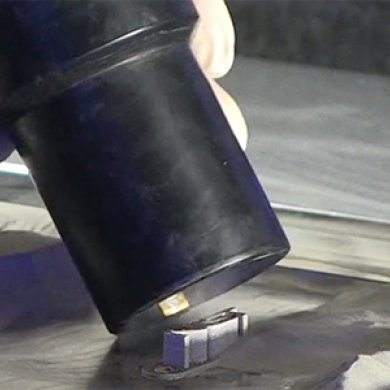31 janvier 2020
By: Joe Gould
WASHINGTON ― Brooklyn-based technology startup goTenna launched in 2014 with a candy bar-sized gadget that pairs with smartphones to create off-grid, no-network communications.
Though it was originally a commercial product, the company has received millions of dollars' worth of government business since 2015, mostly with the U.S. Department of Homeland Security but also with Special Operations Command, the Air Force, the Navy and the Army. About 150,000 devices have shipped.
The Army has spent millions of dollars with goTenna, but the service cannot give the company one of the most important things for a small business ― the certainty of recurring revenue.
“Now the funding is out, and even the program officer for that program doesn't know where we go next within the Army,” goTenna founder and CEO Daniela Perdomo said at a Defense News-hosted roundtable in December. “That's in part why we've been spending more time, frankly, on civilian public safety. Because even though DHS is consistently [under funding restrictions], they seem to be moving. They seem to move faster.”
That sort of inconsistency and confusion is why tech startups dealing with the Pentagon, as well as investors, so dread the gap between their innovative product's development and the Pentagon's sluggish decisions to launch. That gap has a nickname: “the valley of death.”
The Pentagon has experimented with a variety of means to buy emerging technologies, an important goal as it seeks to preserve its edge against Russia and China. But one truism ― affirmed in a recent report from the Ronald Reagan Institute ― is that the federal government has been unable to fully adapt its practices to promote and harness private sector innovation, despite making strides.
Addressing the House Armed Services Committee on Jan. 15, former Under Secretary of Defense for Policy Michele Flournoy said the valley of death between a product's development and the moment that product becomes part of a program of record remains an obstacle. She said that's partly because acquisitions officials don't use the new authorities granted by Congress over recent years.
The excitement of receiving development money from the Department of Defense stands in stark contrast to what often follows.
“[Startups] win the prototype competition: ‘Great, we love you.' And that's in, like, FY19,” Flournoy said. “And then they are told, ‘OK, we are going to have [a request for proposals] for you in '21,' and [the startups] are like: ‘OK, but what do I do in '20? I have got a 10-year hole in my business plan, and my investors are pressuring me to drop the work on DoD because it's too slow, it's too small dollars.'”
How would Flournoy fix it? She advised the Pentagon to hire tech talent ― “smart buyers and developers and fielders of new technologies” ― and create a bridge fund for firms in competitive areas like artificial intelligence, cybersecurity and quantum computing. (The idea seemed to resonate with Texas Rep. Mac Thornberry, who is the panel's top Republican and the author of multiple acquisitions reform laws passed in recent years.)
At the Defense News roundtable, leaders from the tech community said not only has it been difficult for small businesses to enter an aerospace and defense market dominated by five major firms, but it's hard for startups to justify to investors that the government should be retained as a client when it is often the least decisive.
“I think the fundamental misunderstanding between the DoD and venture investors is just how difficult it is to keep the wheels on a fast-growing startup,” said Katherine Boyle of venture capital firm General Catalyst.
But the Pentagon is working to bridge the gap between prototype and production. Over the last year, the Defense Innovation Unit ― the department's outpost in Austin, Texas; Boston, Massachusetts; and California's Silicon Valley ― has launched two internal teams, for defense and commercial engagement, to envision these transitions and match them to the Pentagon's five-year budgeting process, according to DIU's director of strategic engagement, Mike Madsen.
These teams are tasked with learning the needs of the services, working with commercial industry to develop prototypes to meet those needs and then helping market the prototypes more broadly within the Defense Department. Along these lines, DIU helped a company that developed a predictive maintenance application for the Air Force ― Redwood City, California-based C3.ai ― win a predictive maintenance contract for Army ground vehicles. C3.ai has since created a federal arm unit.
A quarter of all prototypes awarded by DIU transitioned to programs of record, and another 50 percent are eligible for the transition. “It will take time for us to develop the right cultural instincts, but it's already happening,” said DIU's director of commercial engagement, Tom Foldesi.
Anduril Industries co-founder and Founders Fund partner Trae Stephens has often criticized the DoD's approach to Silicon Valley. But speaking at the Defense News panel, he acknowledged progress through DIU's ability to harness the flexible other transaction authority, a congressionally mandated contracting mechanism that makes it easier to prototype capabilities. He also praised the Air Force's effort to rework Small Business Innovation Research funds to target more mature technologies.
“I don't know who's responsible for banging the table about it over and over, but somebody is out there saying it," Stephens said. “It seems to be coming across in the messaging in some way.”
https://www.defensenews.com/2020/01/30/tech-startups-still-face-the-pentagons-valley-of-death/


